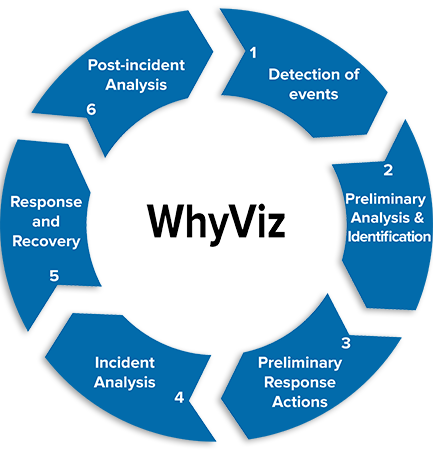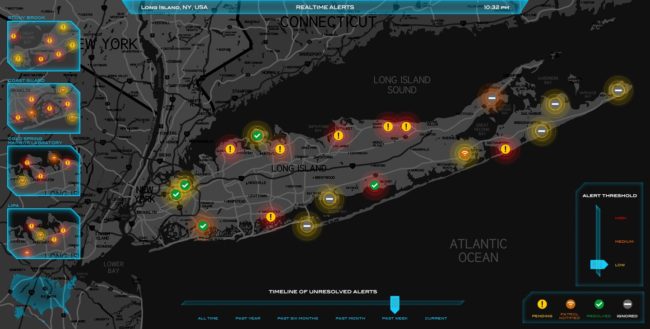Secure Decisions has developed new ways to improve the effectiveness of network operators.
WhyViz – Transforming Cyber Data into Human-Centered Visualizations
 The goal of WhyViz was to conduct a study of the effectiveness of visualizations on cyber operator performance during the early stages of incident handling, which require defense analysts to review an endless alert queue of cyber event data to identify, record, and report suspicious behavior or cyber events of interest. Most cyber security visualizations are currently used for historical analyses, however, as part of the WhyViz project, Secure Decisions developed visualizations to support the real-time, in situ processing as it is actually being performed by cyber operators to facilitate event detection and preliminary event analysis.
The goal of WhyViz was to conduct a study of the effectiveness of visualizations on cyber operator performance during the early stages of incident handling, which require defense analysts to review an endless alert queue of cyber event data to identify, record, and report suspicious behavior or cyber events of interest. Most cyber security visualizations are currently used for historical analyses, however, as part of the WhyViz project, Secure Decisions developed visualizations to support the real-time, in situ processing as it is actually being performed by cyber operators to facilitate event detection and preliminary event analysis.
In Phase I of this Small Business Innovation Research (SBIR), we applied knowledge elicitation (KE) methods to define specific examples of cognitive work that occur in the early stages of incident handling that have the potential for being enhanced (faster, more accurate, more complete) through the use of visualizations by the cyber operator. This cognitive work took the form of the operator seeking to answer specific analytic questions using the available data, in a severely time-constrained work environment. A KE with domain practitioners revealed that cyber operators regularly ask fundamental analytical questions that cut across specific tasks and roles. Our research identified the type of information operators need to answer these questions, the visualization concepts that represent that information in a visual form that can be rapidly comprehended and acted on, and methods to transform raw cyber sensor data into a form that can be used to populate the visualizations. In Phase II of the project (in progress) we will conduct an experiment to objectively evaluate the effects of these visualizations on operator performance.
In Phase II of the project, we conducted an experiment to objectively evaluate the effects of these visualizations on cyber defense analyst performance.
Contract No: FA8650-16-C-6711
DISTRIBUTION STATEMENT A. Approved for public release: distribution is unlimited. 88ABW Cleared 02/08/2017; 88ABW-2017-0518.
MeerCAT®
 Wireless Security Visual Analytics
Wireless Security Visual Analytics
MeerCAT is a visual analytics tool designed to help users locate wireless assets and networks, and assess the risks to their organization. Initially developed for and in close collaboration with the U.S. Department of Defense under a DARPA Small Business Innovation Research (SBIR) program, MeerCAT integrates data from wireless discovery and other security applications with a geographic information system (GIS) to provide a unified view of detected wireless devices, their vulnerabilities and threats.
By visualizing wireless security information, MeerCAT makes it easier for users to visually correlate large volumes of wireless data and see the wireless threats hidden in the haystack of data. MeerCAT simplifies the analysis of wireless data for security and network professionals, and makes the information more accessible for those less skilled. The result is improved efficiency and accuracy in managing wireless security risks, reducing overall costs.
After the initial research was completed, the technology was successfully transitioned and commercialized as MeerCAT-Pro, and was also distributed as a government off-the-shelf product, MeerCAT-FS, which was then incorporated into the Flying Squirrel wireless discovery suite. Because of the successful research and commercialization, DARPA recognized MeerCAT as one of its success stories.
Flying Squirrel Wireless Discovery/Mapping Application Suite

WildCAT™
Wireless Threat Visual Analytics
Critical infrastructures can be vulnerable to cyber attacks through 802.11 wireless networks. WildCAT is a prototype system that enables integration of physical and cyber security resources in order to detect and immediately respond to wireless threats. It is designed to use physical security vehicles as a platform to collect wireless activity and send the data via a cellular network to an analysis center.
VIAssist™
 Network Defense Visualization
Network Defense Visualization
VIAssist is a visual analysis platform to help network security analysts protect their networks. It was designed after a comprehensive cognitive task analysis of network defenders. It provides visual tools for the evaluation of network flow and security data. VIAssist presents multiple, coordinated views – highlighted or filtered data in one view is reflected in all other views – to provide different visual perspectives of the data. These views transform network data into a collection of interactive visualizations that make it easier to analyze data, to see patterns and trends, and to identify risks and actionable information.
 Wireless Security Visual Analytics
Wireless Security Visual Analytics
 Network Defense Visualization
Network Defense Visualization
